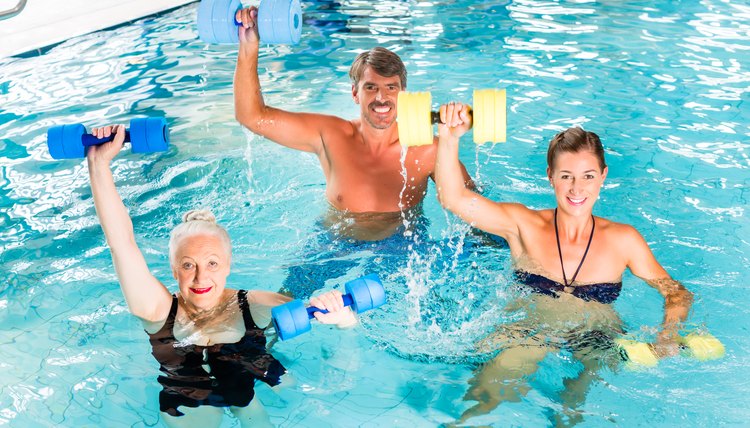How to Teach Water Aerobics

Splashing in the pool is more than fun — it can create a powerful workout. Teaching water aerobics can be an enjoyable and rewarding experience. Because water aerobics is a low-impact class that's very easy on the joints, it's not uncommon to see the elderly, obese or pregnant students in a class.
Your best bet in teaching a class is to find a reputable certifying organization and going through their training. If you've done this, the next step is to plan your class. Get to know the members of your class and learn their limitations. Members are there for a workout, but you also want to provide them with an enjoyable time as they exercise in the water.
Class Levels
Consider the level of your participants when planning a class. Teach a beginners' class by always keeping one foot on the ground and offering movements that are slow and simple. If you choose to move the members across the pool, do so at a walking pace. Pick a series of eight to 10 exercises, and spend about 30 seconds on each. Repeat the entire series throughout the duration of the class. Sample moves for a beginner class include side toe touches, rear kicks, and side leg lifts while holding onto the side of the pool.
Pick up the intensity for an intermediate class by introducing jogging, hopping, side shuffling or anything that requires participants to lift both feet being off the ground at the same time. Speed up arm and leg movements to add resistance to the muscles. You can also introduce water weights, noodles or water shoes for difficulty. Always show the basic version of each exercise first and then allow the members to progress at their own rate.
Regardless of the class level, keep students in constant motion throughout the duration of the class. Perform exercises while running, hopping or gliding across the pool, and have participants use hand fins or water weights for resistance. Depending on the skill level and ability of students, try introducing swimming exercises into your routine.
Types of Water Aerobics Classes
To teach a water aerobics class, you have to have an idea of what "type" you'd like to offer. This informs you of where to place your students, what equipment to use, and the types of moves to offer.
Teach a basic water aerobics class in shallow water that's no higher than the rib cage. This allows members to have more control over their bodies because they will be less buoyant. Simple marches and taps speak to the beginning exerciser's abilities.
Teach a deep water aerobics class in the deeper end of the pool where feet cannot reach the bottom. Everyone should wear a water belt to keep them afloat. This type of class ranges from intermediate to advanced and involves exercises such as treading, full jumping jacks, leg scissors and freestyle or breast stroke swimming exercises. You might use pool noodles for extra fun and flotation.
Teach a prenatal or postnatal class in the shallow or deep end of the pool. Keep the tempo slow to intermediate. Make sure all prenatal and postnatal participants have permission from their doctors first.
Instructor Protocol
Always do a heart rate check several times throughout your class. It is harder to determine a rate of perceived exertion (RPE) in the water as opposed to being on land. Constantly ask students how they feel, and make sure they are breathing correctly. Be cheerful and motivating, and your class will respond to your attitude and spirit.
Teach while in the water or while standing on the pool deck. Being in the water is more personable, but it may be harder for newcomers to learn moves when they can't see your whole body. Teaching from the deck allows everyone to see the exact motion and position of the exercise.
Include music in the background and time your exercises, rather than work to the beat. Music is a great addition, although it might be difficult to sync water exercises to the beat.
Get certified as a lifeguard even though this is not required to teach water aerobics. It never hurts to have extra knowledge regarding water safety.
Writer Bio
Ronny Marie Martin is a certified personal trainer through the American College of Sports Medicine and a certified group exercise instructor through the Aerobics and Fitness Association of America. Martin began writing articles in 2009 and is the fitness contributor for "Urban Views Weekly." She holds a Bachelor of Arts in English from Virginia Polytechnic Institute.
